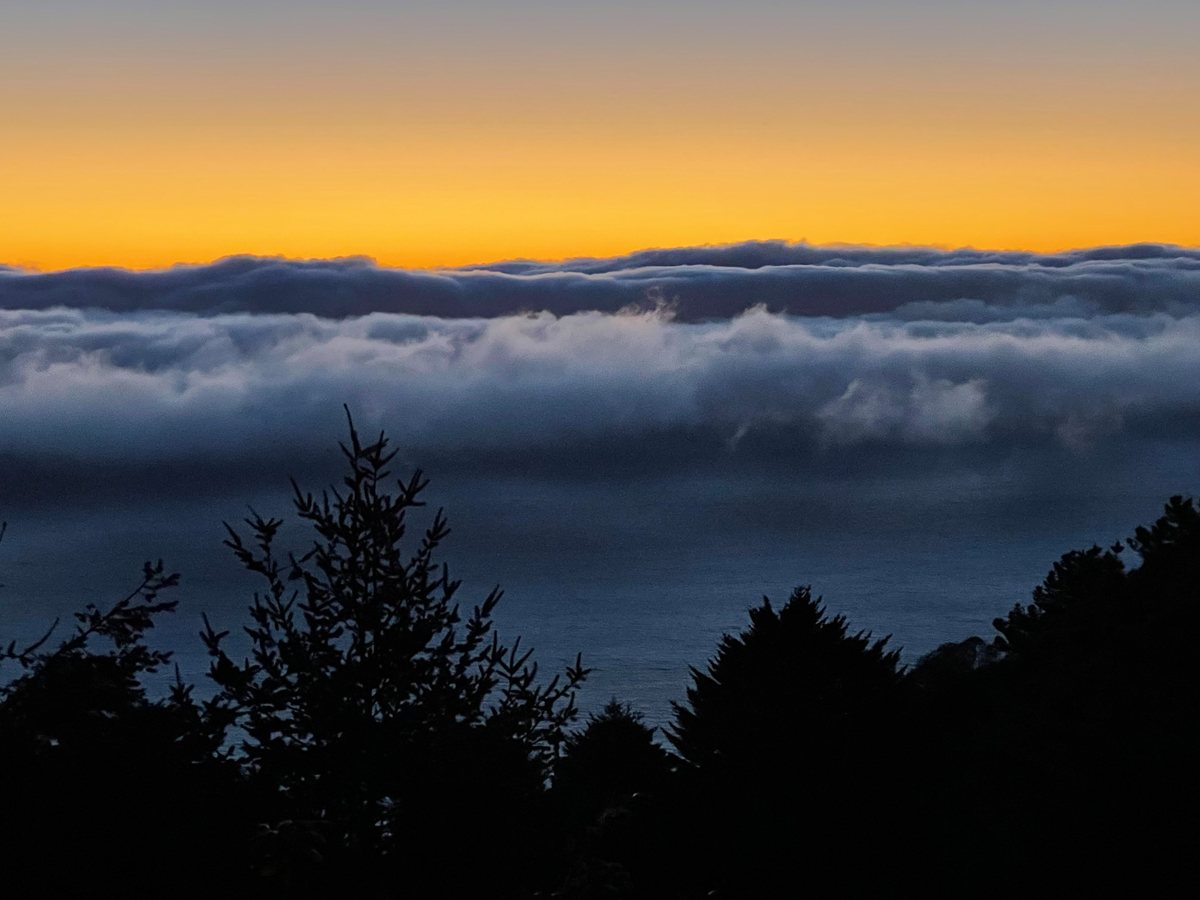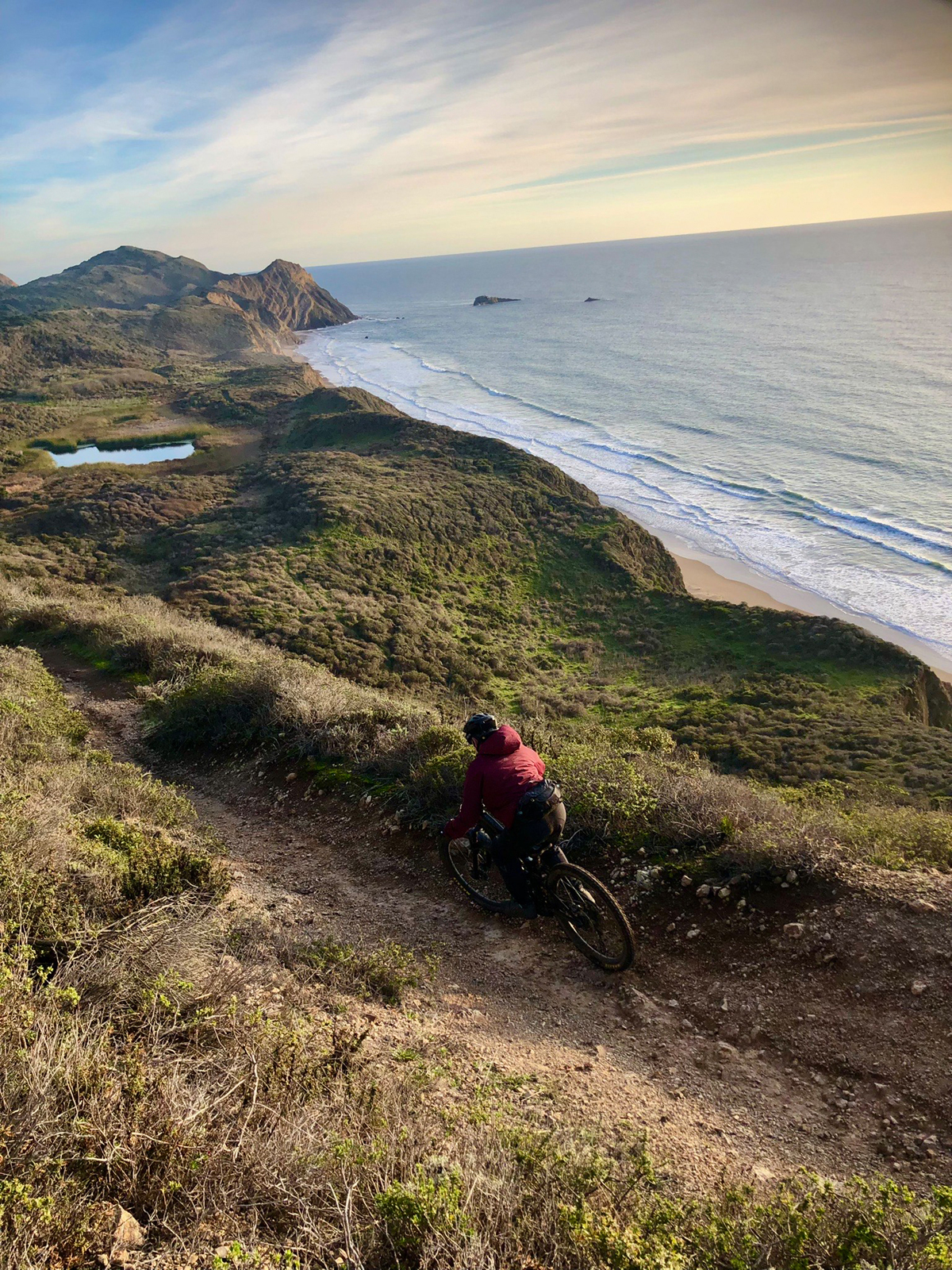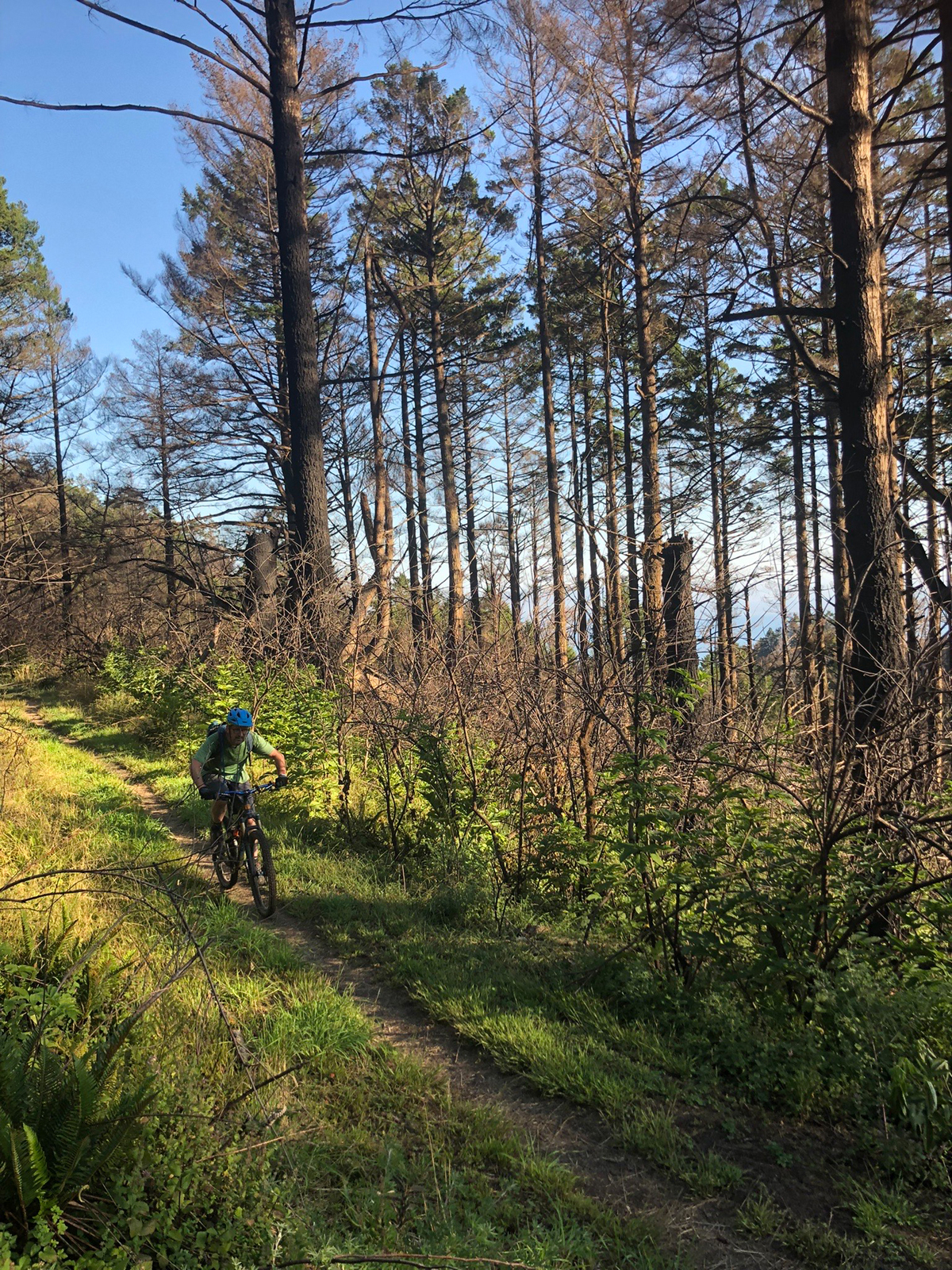It is the poetic spirit (fūrabo), the spirit that leads one to follow nature and become a friend with things of the seasons. — Matsuo Bashō (Japanese haiku master, 1680s)
By Albert Flynn DeSilver — When you cross the San Andreas Fault at Olema, California, you cross over from the North American plate to the Pacific Plate and everything changes. To set foot, horse hooves, or bicycle tires on the Point Reyes peninsula is to land on another continent— geologically literally, of course, but also culturally, even spiritually. It means to land in a unique, more poetic consciousness imbued with the essence of the East.

The Point Reyes peninsula is located just thirty miles north of San Francisco from its south end near Bolinas, forty miles from its midpoint. It lies in the shadow of Mount Tamalpais, the birthplace of mountain biking and the klunker revolution. Though perhaps some of the klunkers were tooling around the hills and dales of Point Reyes in the late seventies and eighties, the peninsula has maintained a remote and inscrutable vibe, courting perhaps a quieter, more contemplative two-wheeled adventurer. The total landmass of the peninsula is just over seventy thousand acres, yet you feel like you have entered a vast wilderness on the scale of Yosemite or Yellowstone.
The only way to properly capture such a vast and dynamic place as the Point Reyes Peninsula is through—what else—the tiniest of compressed art forms, the haiku. As I conceived of this adventure and a piece of writing to follow, the haiku promptly blew into my consciousness like a gust of Japanese plum blossoms snowing in from across the Pacific.
Poet Matsuo Bashō was born in Japan’s Iga region in 1644 and from an early age was drawn to the form called hokku, today known as haiku. By his thirties, he was a hokku master and was fortunate to find fame and financial success in Edo (now Tokyo), but material trappings left him empty, so he wandered the farthest reaches of the country in search of peace and greater communion with nature. Today he is considered Japan’s greatest haiku poet, but he also invented a new form called haibun, which alternates prose with haikus. The haiku is designed to serve as soft punctuation of the words that come before it, a murmur of affirmation.
As we rode across the peninsula, my ride itself came to feel like a haibun’s haiku to all the trips that had preceded it. In the ever-present struggle to put words to experience, this combination of prose and poetry seems closest to capturing Point Reyes’s essence for me.

During the 1906 earthquake the Point Reyes peninsula reportedly “lurched forth more than twenty feet,” and a cow was swallowed up by the fissures torn in the earth. Geologically, the formations from Bear Valley north to the tip of Tomales Point and west to the highpoints of Mount Vision are dominated by granite. This granite isn’t found on along the coast on the mainland North American plate just east of the peninsula, only much farther east when you reach the uplift of the Sierra Nevada. Franciscan undifferentiated sedimentary rock such as graywacke, shale, conglomerate, and chert make up much of the mainland geology just east of the Point Reyes peninsula. In his The Natural History of the Point Reyes Peninsula, Jules Evans describes the peninsula as “the northwesterly migration of a granitic whale,” as if it were floating through geologic time—which of course it is. This “island in time” notion of the place is as much physical and elemental via the geology, flora, and fauna as it is energetic and poetic—which is to say, spiritual.
Last year I asked my wife what she wanted to do for her birthday. “I want to go out to Chimney Rock and see a whale.” “Sure honey,” I told her, “no problem.” A good whale spotting is generally not something one can orchestrate on command, but fantastic husband that I am, I got it scheduled on the calendar and set my intentions alongside hers. When her special day arrived, we drove more than an hour out to the far point, stepped out of the car, and walked maybe two hundred yards down the road toward the old coast-guard station, where I presented her with her whale sighting. We looked down to our left into Drakes Bay, not twenty yards off the pier, and right then a gray whale breached the surface as if to say, “happy birthday, Marian.”
That’s the kind of magical, poetic thing that happens all the time in Point Reyes. That is, if your sensibilities are open (you’re paying attention and truly tuning in), you can sense such magic at the continental threshold. Most people beeline it across Highway 1 at Olema without even noticing. They head for the wild beaches at Abbotts Lagoon, which stretch for miles, or for the famous lighthouse out at the far point proper. Some speed out to see the elk at the north refuge on Tomales Point or the spectacular views from Mount Vision. Still others go for the cliffs, lakes, and waterfall near Palo Marin.
Two things bring me to presence in a place more than any other: writing (poetry) and mountain biking. When I say “bring me to presence,” I mean they wake me back up to a renewed sense of awe and wonder with the natural world. To know a place is not to know “about” it, via the maps, history, place names, or even the scientific nomenclature of the flora and fauna (as fun as all that is), but rather to be in flow with its energies and essences—its poetries. To be in rhythmic harmony with the folds and contours of the landscape itself, enchanted by the low-leaning light, absorbing the radiance of plant, animal, and mineral communication—to allow them space in your bones—this is truly being alive in a place.
elk herd traipsing by
their halo
the rising sun
Though I’ve done a thousand loops and out-and-back rides here, I wanted to see the whole peninsula anew through the lens of poetry on a single day in March at the turn of spring, via an acoustic bicycle. I wanted to celebrate as much of its magical entirety as possible. I brought along my friend C, a consummate adventurer, whom I met, perfectly enough, on a bike ride here in Point Reyes. I’ve been coming to Point Reyes for twenty-six years and have kayaked many of its inlets and esteros, hiked or ridden every one of its roads and trails, swam most of the beaches—but how much of this place did I really know?

When it comes to bike rides, I’m more of a fifteen-mile-once-or-twice-a-week guy. I will never do the Leadville 100 or the Tour Divide. I’ve never actually ridden a bicycle more than twenty-five miles in a day. I’m in it for the nature, for the poetry of being in place. I like to lollygag and talk to the periwinkle, the purple star thistle, the mugwort, the aster, the yarrow, the calla lily. When I scoped out this ride out on a map (yes, a paper map), I honestly did a cursory job, lining up my thumb with the little mileage-scale thing in the lower left-hand corner. I counted twenty-something-ish miles with scant consideration of elevation gain and loss. I had all the hills figured out in my mind as “doable.”
I showed up in the parking lot with a thirty-pound pack complete with three-plus liters of water, two sandwiches, five energy/chocolate bars, and some backup Pata-gucci provisions. I had extra tubes, tools, layers. You’d think we were doing a multi-day trans-Sierra midwinter bike-pack. C showed up with almost nothing. He’d recently experienced a disaster and lost most of his possessions—including his stable of bikes—and he was in full fuck-it-none-of-this-material-shit-matters mode. I lent him my hardtail. Besides that, he had a thirty-ounce water bottle and a couple of energy bars. “What about water?” I asked, reaching for my bladder and taking a comforting slurp from the tube. “I’m good,” he told me. “I can fill up at little streams and whatever along the way. You know that whole giardia thing is a myth.”
*
Vizcaino, one of the first Spanish explorers, called this great triangular peninsula “Punta de Los Reyes” (point of the kings). The coast Miwok called the surrounding bay waters tamál-húye, or simply home, since it was the place they had continually inhabited for more than five thousand years. By the 1850s, Portuguese dairy farmers began sectioning off the vast tracts by lettering them and building ranches. An old map reads like scattered Scrabble letters tossed across an empty board. To this day the signs along Sir Francis Drake Boulevard read “Historic A Ranch,” “Historic H Ranch,” “Historic L Ranch,” and so on. The ranches are in decline and the elk are back. There is a space near the Bear Valley visitor’s center in which to honor the Miwok with a model village called Kule Loklo (bear valley). The last grizzly was killed in 1913, though every twenty years or so a stray black bear wanders down from Mendocino. Every year a powwow here celebrates coast Miwok culture, and this is the go-to field-trip destination for surrounding Bay Area schools.
I’m not sure when the poets started showing up, but some of America’s greatest have written and/or lived here. Gary Snyder with his famous poem about hanging out down at McClure’s beach with Jack Kerouac in the fifties. Robert Bly and his men’s groups, poeming about in the seventies and eighties. Bob Haas and Brenda Hillman still have a place here. Bolinas has the peninsula’s strongest history in this regard. Allen Ginsberg lived there for a while in the sixties along with Philip Whalen, Robert Creeley, Bill Berkson, Joanne Kyger, Anne Waldman, and so many others. Like I did, they came to re-experience the origins of language—which ultimately belong to the string of snowy plover footprints in the sand down at Drakes Beach, the scrawl of bishop pine branches scratching at the clouds above Mount Vision, and the traces of a redtail hawk’s thermal rise into the sky over Pelican Lake.
*
We set off at dawn from the north tip of the peninsula at the Tomales Point parking lot, taking in an elk herd cantering along a small rise, backlit by the brightening eastern sky. After shooting a few happy snaps, we burn pavement from the McClures Beach turnoff and climb south. A mile or so later of pavement, we veer off near the Pierce Point Ranch on the bay side, climb through a barbed-wire fence, and pick up a game trail (stray elk, fox, coyote, deer, bobcat, skunk, perhaps raccoon and possum—I imagine them all prowling along sniffing out the cows) and we too ride the fence line that takes us over to the Marshall’s Beach road.
swatch of blazing mustard flowers,
bright green fields spotted
with spotted cows—
the oceans roars
We pause at the top of the Marshall’s Beach parking area. There’s an old road that leads down to the legendary artist Clayton Lewis’s place at Lairds Landing. He had a small cottage and sculpture studio down there for years, more or less squatting until eventually the park service forced him out. In the sixties and seventies, when he was living there full time, he’d reportedly row across the bay to get groceries at the Marshall store and mail his famously decorated envelopes filled with poetic letters to friends and family. Up until the nineties, this was the ultimate romantic place to take a lover, to explore the old buildings and studio, to drop the rope swing from the cypress tree and swing out over the water, to skinny-dip in the bay and lie around naked in the warm sand. The park has since cut the rope swing, cleared out some of the debris, and let the outbuildings collapse.
We pedal on for a couple of miles down a wide gravel ranch road into the lower bishop pine forest. You don’t see these trees east of the San Andreas Fault, as they thrive in granite soils. The bishop pines sing a different song with their paired dark-blue-green needles, creating a humming low-pitched whisper: a voice that says, “wake up and smell the poetry.” Scent is always on the wind here, alternating between saline air, crushed huckleberry, and citrusy pine pitch. As you ride up in elevation you feel as if you are being dipped in a Japanese brush painting—especially when the cold air streams in off the Pacific and collides with the warmer air of the mainland, filling the forest with vaporous gray veils that stream through the branches, creating moody ghosts of the surrounding snags.
Our route takes us along another half-mile run of pavement on Sir Francis Drake Boulevard over to the base of Ottinger’s Hill, a fire-road cutoff that runs steeply to the top of Mount Vision at 1,283 feet above the sea.
a window framed
by bishop branches
Irish pastures, strip of cobalt ocean—
the horizon smiles
Onward to the top of Mount Vision, site of the great fire of 1995, which destroyed forty-five homes east of the park and charred 15 percent of the seashore lands. The view is in fact visionary, with Tomales Bay stretching out to the left and the vast gleaming Pacific unraveling to the right. This fast steep drop along Inverness Ridge gives us our first taste of singletrack, providing many a yip and holler, a couple of wide smiles, and if not a fist bump, then certainly an elbow-to-elbow tap (as the pandemic rolls on).
Still no fog by midday as we arrive at Bayview, with unobstructed views back at Mount Vision and down to Drakes and Limantour beaches. We contour another bit of pavement to the Sky Camp trailhead and notice it is still closed due to last summer’s lightning-strike fires that set much of Northern California ablaze, including another five-thousand-plus acres between here and Bear Valley. We descend the wide curves of Limantour Road whizzing most of the way down in a tuck, then pause at a small rise to take in the successful roadside backburn that saved the Fox and Inverness Park neighborhoods.
pair of black vultures
glide between two
burnt trees—
not a word between them
At the bottom of Limantour Road our route takes us on through the rift-zone gut of the San Andreas Fault, paralleling Highway 1 for a few more miles of pavement until we turn off at the Five Brooks trailhead. Even “burning” road here is a thrill: between the swish of cars as you listen for the bap-bap-bap stutter of tires hitting the strange median reflectors on California’s rural roads, signaling the driver sees you and is moving even slightly around you. Then there’s the unexpected finds like the Olema Lime Kilns, built in 1850 on land leased from Mexican grantee Rafael Garcia by two enterprising Forty-Niners. From the bike, roadside not far south of Olema, you can spot the kilns (now just a mossy cluster of stones wrapped in blackberry vines). To ride the peninsula—whether road burn, ranch road, or singletrack—is to feel the perpetual tectonic buzz beneath your tires as you straddle two continents.
At Five Brooks, we take the Stewart Trail fire road, meandering at about 3-percent grade up to Fir Top at 1,342 feet. Here we welcome the embrace of a mature fir forest dripping with sage-colored drapery commonly known as “Spanish moss,” actually a beard-like lace lichen known scientifically as Ramalina menziesii. You can pedal all the way out to the ocean at Glenn and Wildcat camps, but to do so would add ten-plus miles and 1,500 feet of climbing.
We decide we’re doing great in both departments and opt for the Olema Valley Trail, a kind of seismic zipper running north-south down the belly of the fault. (It’s best ridden this direction: after a punchy climb out of Five Brooks it’s mostly downhill.) This is a gorgeous four-and-a-half-mile stretch of trail that rolls in and out of meadows sprinkled with coyote brush and shoulder-high stands of Queen Anne’s lace. In spring the trail is edged with thigh-high clusters of stinging nettles, which upon the slighted graze set your skin ablaze—leaving not so much an itch or burn as a weird buzzing throb that can last for a days. The trail dips, rises, and swoops into dense stands of oak, alder and bay laurel following a winding creek south to Dogtown.
We’re back out on Highway 1 at Dogtown, blurring by fat stands of roadside eucalyptus for the final stretch via “Seventeen S’s” to Horseshoe Hill Road, blinking by gorgeous farmhouses, the old Saint Mary Magdalene Mission church and graveyard overlooking Bolinas Lagoon, and the famous “peace barn” just outside of town. To complete the journey, we pedal up to the mesa past Agate Beach off Ocean Parkway, which lands us at our final southern destination near Duxbury Point, where we take in a deep saline breath, sponging up the full spirit of the Pacific plate.
snowy egret
perched in church’s shadow
stabs a shimmery blue fish
with its yellow beak
I thought about the thousand other rides I’ve done in this place, including that epic full-moon night ride out to Drakes Head for my friend Fuzzy’s birthday a couple of years before he died. Twenty of us had a giant bonfire out by the cow pond. Someone brought pints of ice cream; another brought several pounds of shrimp scampi, full bottles of wine, and plenty of weed. We didn’t get back to the car until four in the morning.
Yet on this through ride—as we avoided an unexpected spring storm roaring in off the Pacific, being pounced upon by a foamy-mouthed mountain lion, or tearing open a thigh on rusty barbed wire, thus needing to improvise a tourniquet with some tule reeds—something more profound emerged.
It takes time for giardia to show up, but at last check C’s stomach was fine. Point to point, we ended up riding forty-plus miles and logging more than six thousand feet of climbing—a decent-sized adventure, which allowed us to become better “friends with the things of the seasons,” to cultivate a deeper enchantment with our local watershed, and to allow our hearts and minds to become further imprinted by another continent’s poetry.
cliff’s edge, gulls cry, rocks shine
white necklaces of foam
sizzle and dissolve
Albert Flynn DeSilver is the former Marin County Poet Laureate.
Excerpted from the book Singletrack Mind: Finding Wisdom & the Poetry of Life on Two Wheels; the nonexistent press, 2023 and available at www.singletrackmindbook.com.
This piece first appeared in Adventure Journal 21 with gratitude to Steve Casimiro.








